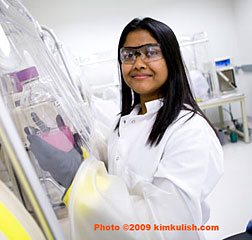- Number 372 |
- September 24, 2012
Aindrila Mukhopadhyay’s two missions: Bioenergy and art

Aindrila Mukhopadhyay’s daytime mission is
science, studying microbial stress and
response in order to further the production
of biofuels. After hours, she turns to art,
sketching scenes in the Mission, her
San Francisco neighborhood.
In her laboratory at the Joint BioEnergy Institute (JBEI), microbiologist Aindrila Mukhopadhyay of DOE's Lawrence Berkeley National Laboratory’s Physical Biosciences Division juggles anaerobic glove boxes, gene-copying PCR machines, centrifuges, and Erlenmeyer flasks. At home in San Francisco’s Mission District, the instruments are a bit simpler: a hand pencil sharpener, a sketchbook, and a pair of No. 2B soft graphite sketching pencils.
Self-taught and self-effacing, Aindrila (pronounced Oin-Drill-la) has built a following for her black-and-white drawings of her colorful neighborhood. Her originals have sold in local galleries and cafes, and seven of them were published in The Comic Book Guide to the Mission, a collection celebrating local culture and the work of Mission District artists. Many of her sketches can be seen on her website, and with her photography too, she shows an eye for cultural diversity and architectural charm.
A native of Bengal, India, Aindrila loves the bustling, multi-cultural life of the Mission, where she lives with her husband and young son. “I like to capture the energy of the place,” she says of her drawings, which she calls, “my little doodles.” Motherhood has, in fact, taken a bite out of her doodling time, but the passion for an artistic time-out is as strong as ever.
There is no question that she also enjoys her day jobs. She heads the Mukhopadhyay Group, an interdisciplinary team whose overall interests are signaling and stress response in both environmental and engineered organisms. “Recently we have become interested in studying signaling and response in cyanobacteria that dominate desert soil crusts.”
For DOE’s ENIGMA project, her group studies Desulfovibrio vulgaris, an anaerobic bacterium capable of taking water-soluble metals out of solution — a trait that could be harnessed to keep pollutants out of water supplies. At JBEI, her Biofuels Toxicity and Tolerance Group is tackling the problem of how to protect fuel-producing microbes from poisoning themselves with their desired byproducts, and her second JBEI group is engaged in biochemical analysis of biofuels production using functional genomics, proteomics, and metabolomics — and hence is named, with a bit of scientific/artistic tongue-in-cheek, “The Omics Group.”
While laboratory science and sketchbook art may not seem a natural fit, Aindrila finds they have much in common. “Both areas require creativity and imagination,” she says. “And like any other skill, the more you draw or create experiments, the better you get at it, and the more you enjoy it.”Submitted by DOE's Lawrence Berkeley National Laboratory
